Maternal Protectiveness and Domestic Violence
VerifiedAdded on 2020/05/28
|8
|2112
|116
AI Summary
This assignment examines the concept of maternal protectiveness in the context of children who have witnessed domestic violence during their upbringing. It delves into the experiences and perspectives of individuals who have gone through such situations, emphasizing the need for social workers to understand the multifaceted nature of this phenomenon. The assignment also discusses limitations of current research and suggests directions for future studies that could shed light on the positive and negative aspects of maternal protectiveness in relation to child well-being.
Contribute Materials
Your contribution can guide someone’s learning journey. Share your
documents today.
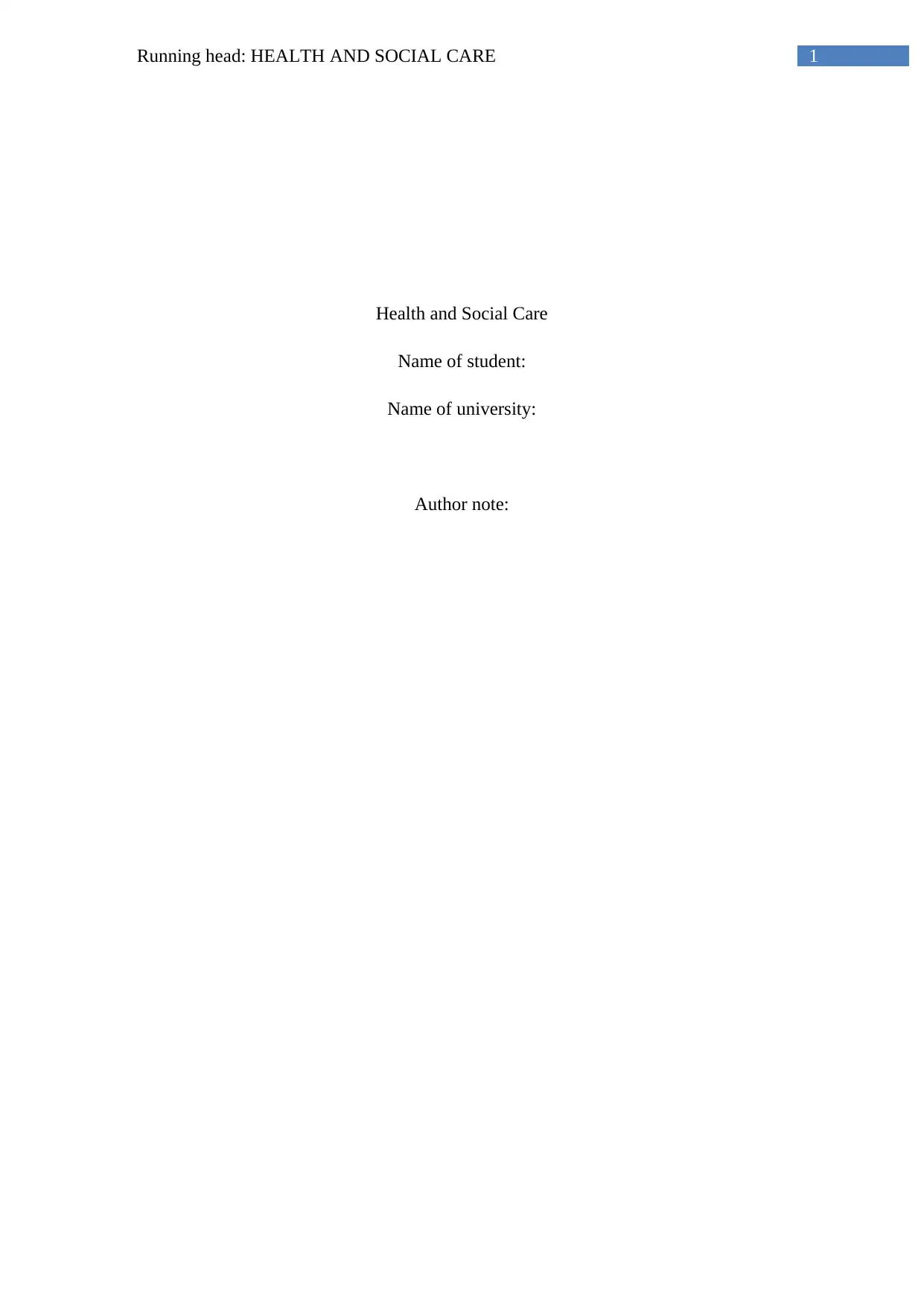
1Running head: HEALTH AND SOCIAL CARE
Health and Social Care
Name of student:
Name of university:
Author note:
Health and Social Care
Name of student:
Name of university:
Author note:
Secure Best Marks with AI Grader
Need help grading? Try our AI Grader for instant feedback on your assignments.
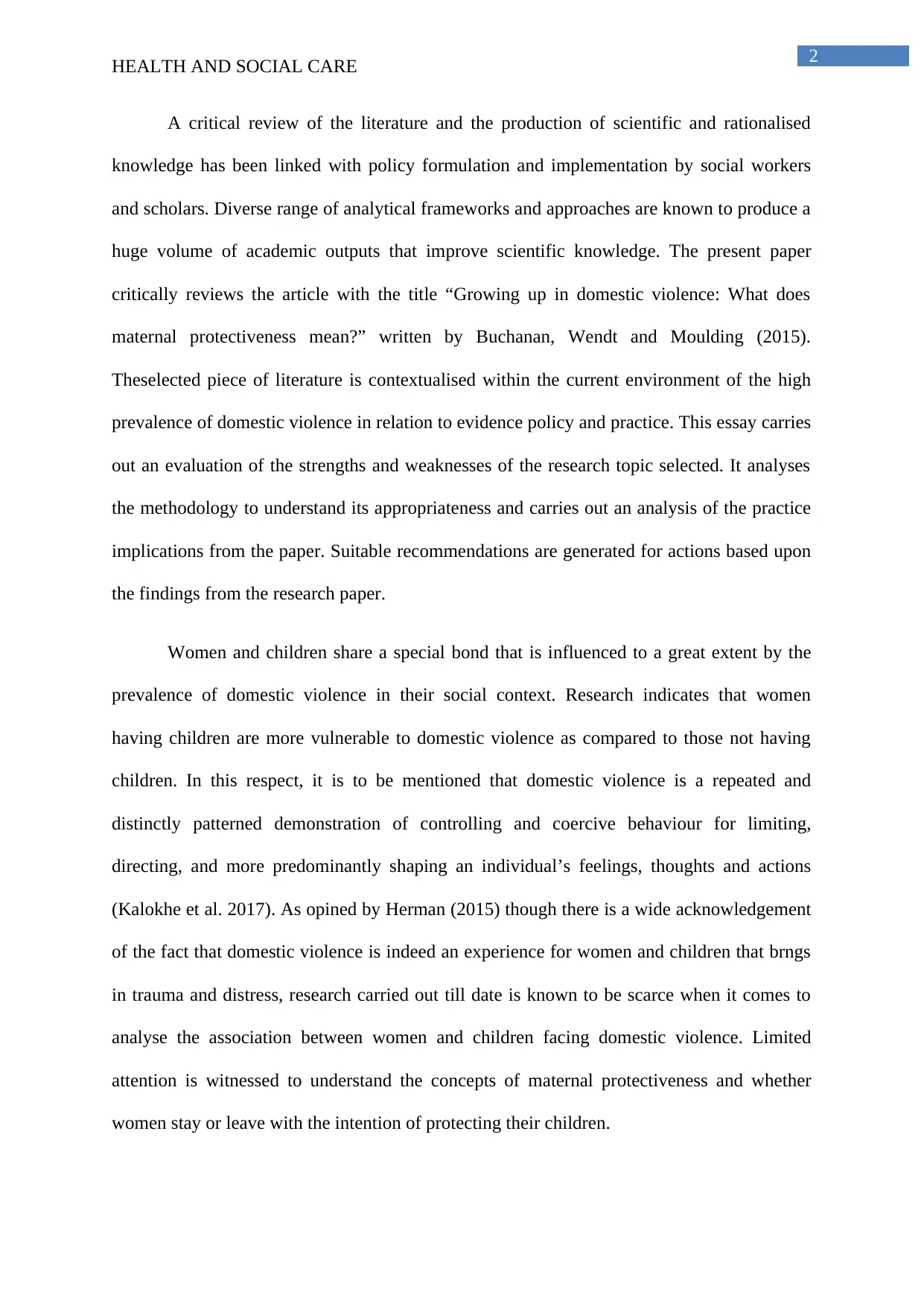
2
HEALTH AND SOCIAL CARE
A critical review of the literature and the production of scientific and rationalised
knowledge has been linked with policy formulation and implementation by social workers
and scholars. Diverse range of analytical frameworks and approaches are known to produce a
huge volume of academic outputs that improve scientific knowledge. The present paper
critically reviews the article with the title “Growing up in domestic violence: What does
maternal protectiveness mean?” written by Buchanan, Wendt and Moulding (2015).
Theselected piece of literature is contextualised within the current environment of the high
prevalence of domestic violence in relation to evidence policy and practice. This essay carries
out an evaluation of the strengths and weaknesses of the research topic selected. It analyses
the methodology to understand its appropriateness and carries out an analysis of the practice
implications from the paper. Suitable recommendations are generated for actions based upon
the findings from the research paper.
Women and children share a special bond that is influenced to a great extent by the
prevalence of domestic violence in their social context. Research indicates that women
having children are more vulnerable to domestic violence as compared to those not having
children. In this respect, it is to be mentioned that domestic violence is a repeated and
distinctly patterned demonstration of controlling and coercive behaviour for limiting,
directing, and more predominantly shaping an individual’s feelings, thoughts and actions
(Kalokhe et al. 2017). As opined by Herman (2015) though there is a wide acknowledgement
of the fact that domestic violence is indeed an experience for women and children that brngs
in trauma and distress, research carried out till date is known to be scarce when it comes to
analyse the association between women and children facing domestic violence. Limited
attention is witnessed to understand the concepts of maternal protectiveness and whether
women stay or leave with the intention of protecting their children.
HEALTH AND SOCIAL CARE
A critical review of the literature and the production of scientific and rationalised
knowledge has been linked with policy formulation and implementation by social workers
and scholars. Diverse range of analytical frameworks and approaches are known to produce a
huge volume of academic outputs that improve scientific knowledge. The present paper
critically reviews the article with the title “Growing up in domestic violence: What does
maternal protectiveness mean?” written by Buchanan, Wendt and Moulding (2015).
Theselected piece of literature is contextualised within the current environment of the high
prevalence of domestic violence in relation to evidence policy and practice. This essay carries
out an evaluation of the strengths and weaknesses of the research topic selected. It analyses
the methodology to understand its appropriateness and carries out an analysis of the practice
implications from the paper. Suitable recommendations are generated for actions based upon
the findings from the research paper.
Women and children share a special bond that is influenced to a great extent by the
prevalence of domestic violence in their social context. Research indicates that women
having children are more vulnerable to domestic violence as compared to those not having
children. In this respect, it is to be mentioned that domestic violence is a repeated and
distinctly patterned demonstration of controlling and coercive behaviour for limiting,
directing, and more predominantly shaping an individual’s feelings, thoughts and actions
(Kalokhe et al. 2017). As opined by Herman (2015) though there is a wide acknowledgement
of the fact that domestic violence is indeed an experience for women and children that brngs
in trauma and distress, research carried out till date is known to be scarce when it comes to
analyse the association between women and children facing domestic violence. Limited
attention is witnessed to understand the concepts of maternal protectiveness and whether
women stay or leave with the intention of protecting their children.
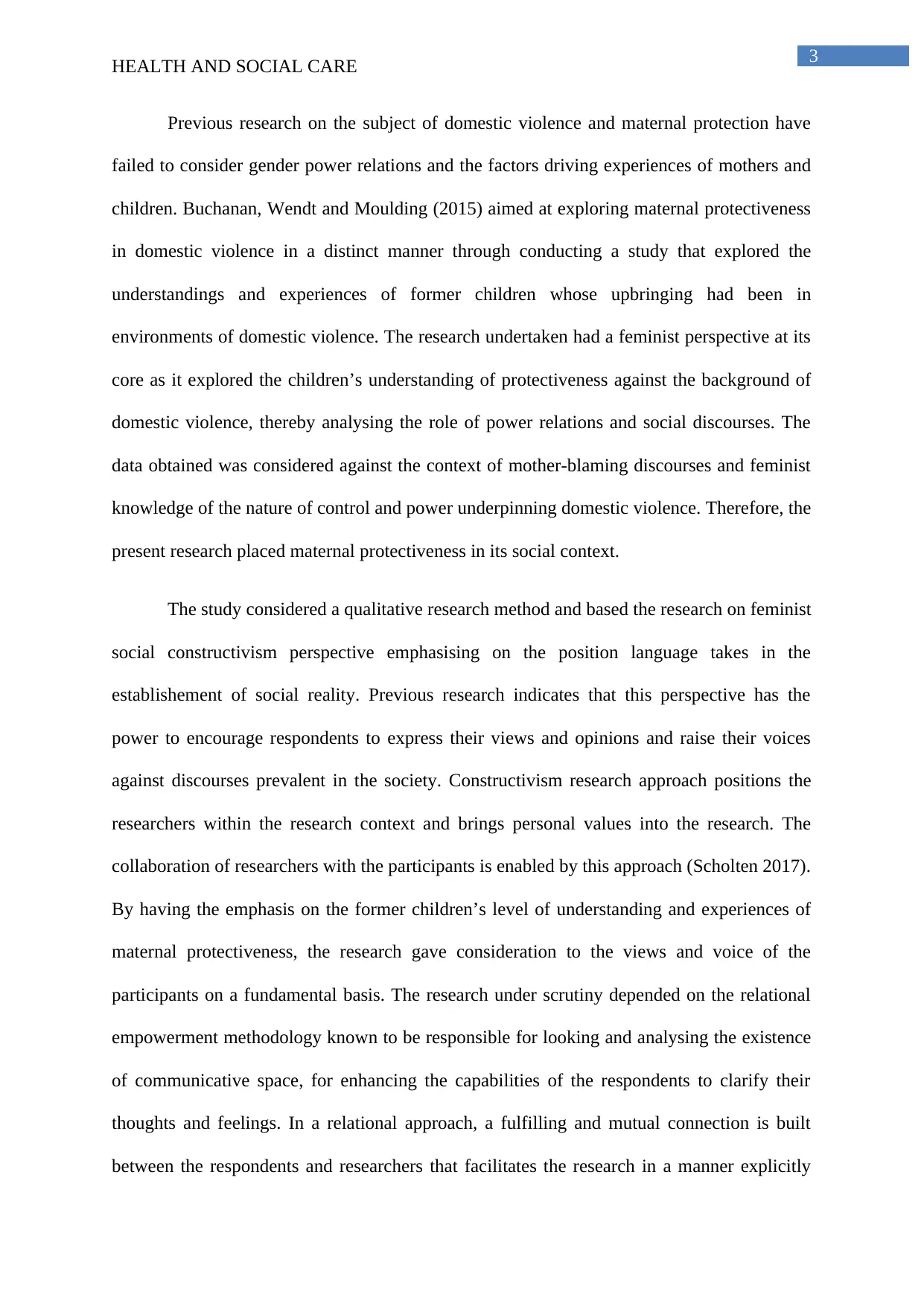
3
HEALTH AND SOCIAL CARE
Previous research on the subject of domestic violence and maternal protection have
failed to consider gender power relations and the factors driving experiences of mothers and
children. Buchanan, Wendt and Moulding (2015) aimed at exploring maternal protectiveness
in domestic violence in a distinct manner through conducting a study that explored the
understandings and experiences of former children whose upbringing had been in
environments of domestic violence. The research undertaken had a feminist perspective at its
core as it explored the children’s understanding of protectiveness against the background of
domestic violence, thereby analysing the role of power relations and social discourses. The
data obtained was considered against the context of mother-blaming discourses and feminist
knowledge of the nature of control and power underpinning domestic violence. Therefore, the
present research placed maternal protectiveness in its social context.
The study considered a qualitative research method and based the research on feminist
social constructivism perspective emphasising on the position language takes in the
establishement of social reality. Previous research indicates that this perspective has the
power to encourage respondents to express their views and opinions and raise their voices
against discourses prevalent in the society. Constructivism research approach positions the
researchers within the research context and brings personal values into the research. The
collaboration of researchers with the participants is enabled by this approach (Scholten 2017).
By having the emphasis on the former children’s level of understanding and experiences of
maternal protectiveness, the research gave consideration to the views and voice of the
participants on a fundamental basis. The research under scrutiny depended on the relational
empowerment methodology known to be responsible for looking and analysing the existence
of communicative space, for enhancing the capabilities of the respondents to clarify their
thoughts and feelings. In a relational approach, a fulfilling and mutual connection is built
between the respondents and researchers that facilitates the research in a manner explicitly
HEALTH AND SOCIAL CARE
Previous research on the subject of domestic violence and maternal protection have
failed to consider gender power relations and the factors driving experiences of mothers and
children. Buchanan, Wendt and Moulding (2015) aimed at exploring maternal protectiveness
in domestic violence in a distinct manner through conducting a study that explored the
understandings and experiences of former children whose upbringing had been in
environments of domestic violence. The research undertaken had a feminist perspective at its
core as it explored the children’s understanding of protectiveness against the background of
domestic violence, thereby analysing the role of power relations and social discourses. The
data obtained was considered against the context of mother-blaming discourses and feminist
knowledge of the nature of control and power underpinning domestic violence. Therefore, the
present research placed maternal protectiveness in its social context.
The study considered a qualitative research method and based the research on feminist
social constructivism perspective emphasising on the position language takes in the
establishement of social reality. Previous research indicates that this perspective has the
power to encourage respondents to express their views and opinions and raise their voices
against discourses prevalent in the society. Constructivism research approach positions the
researchers within the research context and brings personal values into the research. The
collaboration of researchers with the participants is enabled by this approach (Scholten 2017).
By having the emphasis on the former children’s level of understanding and experiences of
maternal protectiveness, the research gave consideration to the views and voice of the
participants on a fundamental basis. The research under scrutiny depended on the relational
empowerment methodology known to be responsible for looking and analysing the existence
of communicative space, for enhancing the capabilities of the respondents to clarify their
thoughts and feelings. In a relational approach, a fulfilling and mutual connection is built
between the respondents and researchers that facilitates the research in a manner explicitly
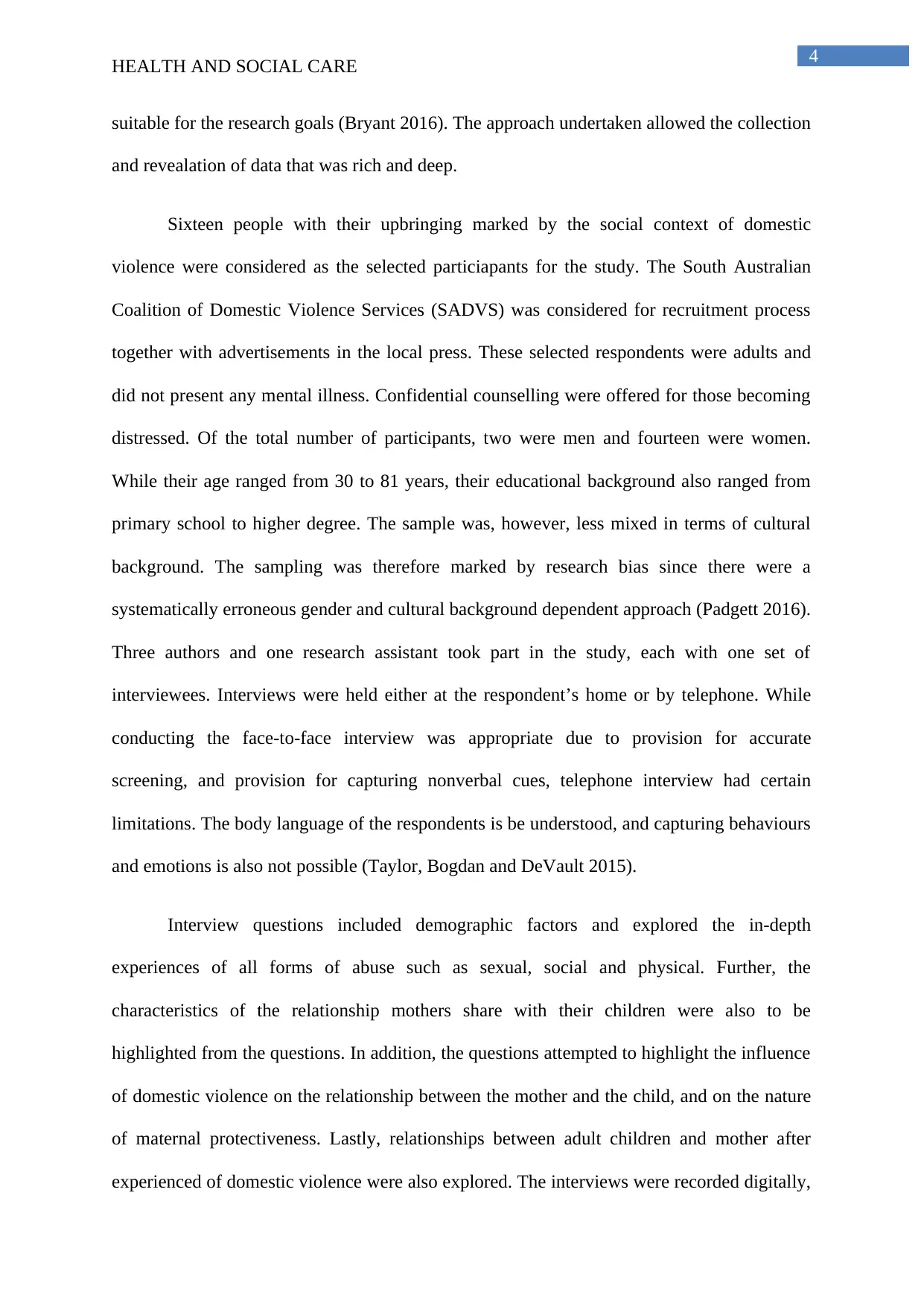
4
HEALTH AND SOCIAL CARE
suitable for the research goals (Bryant 2016). The approach undertaken allowed the collection
and revealation of data that was rich and deep.
Sixteen people with their upbringing marked by the social context of domestic
violence were considered as the selected particiapants for the study. The South Australian
Coalition of Domestic Violence Services (SADVS) was considered for recruitment process
together with advertisements in the local press. These selected respondents were adults and
did not present any mental illness. Confidential counselling were offered for those becoming
distressed. Of the total number of participants, two were men and fourteen were women.
While their age ranged from 30 to 81 years, their educational background also ranged from
primary school to higher degree. The sample was, however, less mixed in terms of cultural
background. The sampling was therefore marked by research bias since there were a
systematically erroneous gender and cultural background dependent approach (Padgett 2016).
Three authors and one research assistant took part in the study, each with one set of
interviewees. Interviews were held either at the respondent’s home or by telephone. While
conducting the face-to-face interview was appropriate due to provision for accurate
screening, and provision for capturing nonverbal cues, telephone interview had certain
limitations. The body language of the respondents is be understood, and capturing behaviours
and emotions is also not possible (Taylor, Bogdan and DeVault 2015).
Interview questions included demographic factors and explored the in-depth
experiences of all forms of abuse such as sexual, social and physical. Further, the
characteristics of the relationship mothers share with their children were also to be
highlighted from the questions. In addition, the questions attempted to highlight the influence
of domestic violence on the relationship between the mother and the child, and on the nature
of maternal protectiveness. Lastly, relationships between adult children and mother after
experienced of domestic violence were also explored. The interviews were recorded digitally,
HEALTH AND SOCIAL CARE
suitable for the research goals (Bryant 2016). The approach undertaken allowed the collection
and revealation of data that was rich and deep.
Sixteen people with their upbringing marked by the social context of domestic
violence were considered as the selected particiapants for the study. The South Australian
Coalition of Domestic Violence Services (SADVS) was considered for recruitment process
together with advertisements in the local press. These selected respondents were adults and
did not present any mental illness. Confidential counselling were offered for those becoming
distressed. Of the total number of participants, two were men and fourteen were women.
While their age ranged from 30 to 81 years, their educational background also ranged from
primary school to higher degree. The sample was, however, less mixed in terms of cultural
background. The sampling was therefore marked by research bias since there were a
systematically erroneous gender and cultural background dependent approach (Padgett 2016).
Three authors and one research assistant took part in the study, each with one set of
interviewees. Interviews were held either at the respondent’s home or by telephone. While
conducting the face-to-face interview was appropriate due to provision for accurate
screening, and provision for capturing nonverbal cues, telephone interview had certain
limitations. The body language of the respondents is be understood, and capturing behaviours
and emotions is also not possible (Taylor, Bogdan and DeVault 2015).
Interview questions included demographic factors and explored the in-depth
experiences of all forms of abuse such as sexual, social and physical. Further, the
characteristics of the relationship mothers share with their children were also to be
highlighted from the questions. In addition, the questions attempted to highlight the influence
of domestic violence on the relationship between the mother and the child, and on the nature
of maternal protectiveness. Lastly, relationships between adult children and mother after
experienced of domestic violence were also explored. The interviews were recorded digitally,
Secure Best Marks with AI Grader
Need help grading? Try our AI Grader for instant feedback on your assignments.
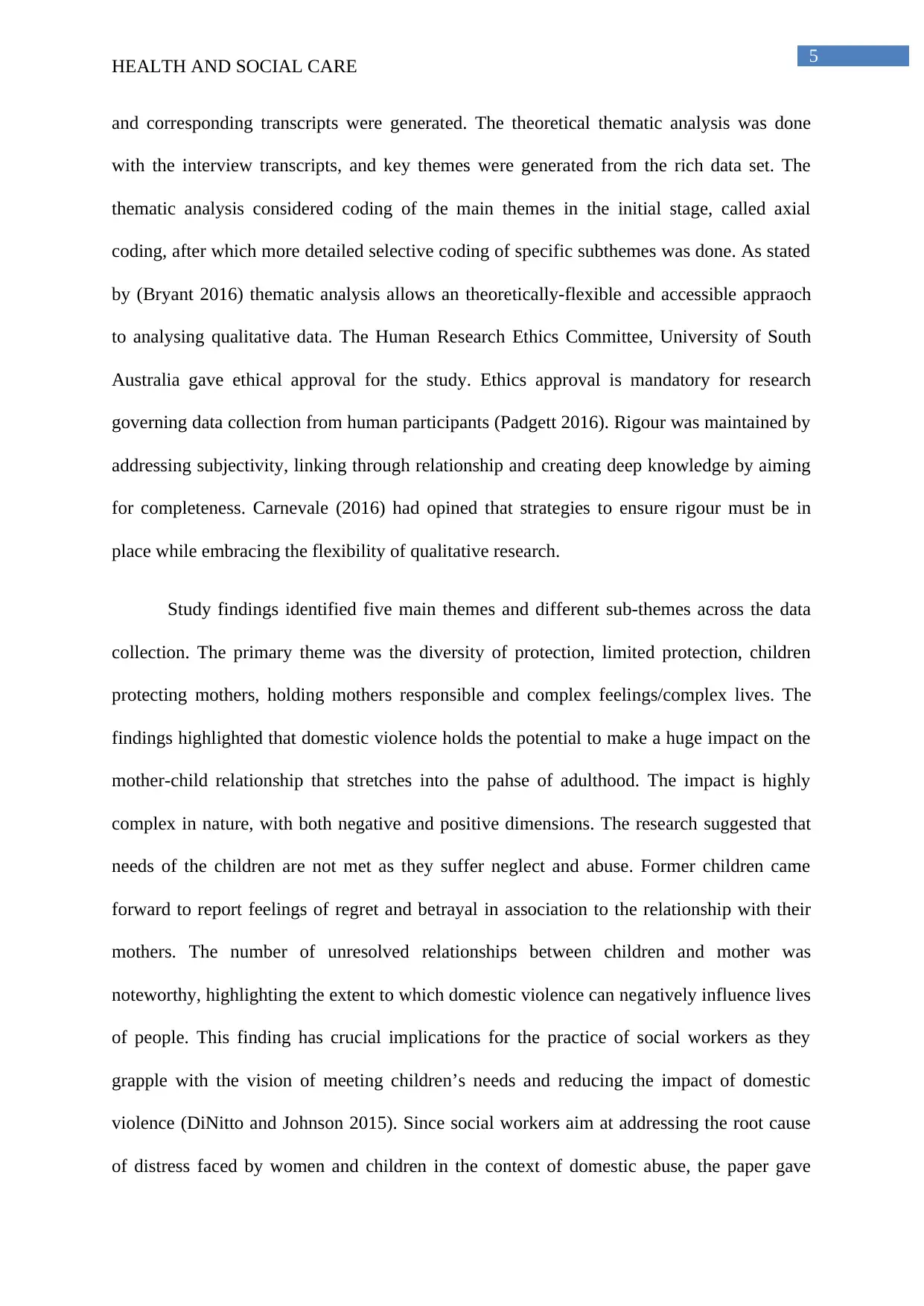
5
HEALTH AND SOCIAL CARE
and corresponding transcripts were generated. The theoretical thematic analysis was done
with the interview transcripts, and key themes were generated from the rich data set. The
thematic analysis considered coding of the main themes in the initial stage, called axial
coding, after which more detailed selective coding of specific subthemes was done. As stated
by (Bryant 2016) thematic analysis allows an theoretically-flexible and accessible appraoch
to analysing qualitative data. The Human Research Ethics Committee, University of South
Australia gave ethical approval for the study. Ethics approval is mandatory for research
governing data collection from human participants (Padgett 2016). Rigour was maintained by
addressing subjectivity, linking through relationship and creating deep knowledge by aiming
for completeness. Carnevale (2016) had opined that strategies to ensure rigour must be in
place while embracing the flexibility of qualitative research.
Study findings identified five main themes and different sub-themes across the data
collection. The primary theme was the diversity of protection, limited protection, children
protecting mothers, holding mothers responsible and complex feelings/complex lives. The
findings highlighted that domestic violence holds the potential to make a huge impact on the
mother-child relationship that stretches into the pahse of adulthood. The impact is highly
complex in nature, with both negative and positive dimensions. The research suggested that
needs of the children are not met as they suffer neglect and abuse. Former children came
forward to report feelings of regret and betrayal in association to the relationship with their
mothers. The number of unresolved relationships between children and mother was
noteworthy, highlighting the extent to which domestic violence can negatively influence lives
of people. This finding has crucial implications for the practice of social workers as they
grapple with the vision of meeting children’s needs and reducing the impact of domestic
violence (DiNitto and Johnson 2015). Since social workers aim at addressing the root cause
of distress faced by women and children in the context of domestic abuse, the paper gave
HEALTH AND SOCIAL CARE
and corresponding transcripts were generated. The theoretical thematic analysis was done
with the interview transcripts, and key themes were generated from the rich data set. The
thematic analysis considered coding of the main themes in the initial stage, called axial
coding, after which more detailed selective coding of specific subthemes was done. As stated
by (Bryant 2016) thematic analysis allows an theoretically-flexible and accessible appraoch
to analysing qualitative data. The Human Research Ethics Committee, University of South
Australia gave ethical approval for the study. Ethics approval is mandatory for research
governing data collection from human participants (Padgett 2016). Rigour was maintained by
addressing subjectivity, linking through relationship and creating deep knowledge by aiming
for completeness. Carnevale (2016) had opined that strategies to ensure rigour must be in
place while embracing the flexibility of qualitative research.
Study findings identified five main themes and different sub-themes across the data
collection. The primary theme was the diversity of protection, limited protection, children
protecting mothers, holding mothers responsible and complex feelings/complex lives. The
findings highlighted that domestic violence holds the potential to make a huge impact on the
mother-child relationship that stretches into the pahse of adulthood. The impact is highly
complex in nature, with both negative and positive dimensions. The research suggested that
needs of the children are not met as they suffer neglect and abuse. Former children came
forward to report feelings of regret and betrayal in association to the relationship with their
mothers. The number of unresolved relationships between children and mother was
noteworthy, highlighting the extent to which domestic violence can negatively influence lives
of people. This finding has crucial implications for the practice of social workers as they
grapple with the vision of meeting children’s needs and reducing the impact of domestic
violence (DiNitto and Johnson 2015). Since social workers aim at addressing the root cause
of distress faced by women and children in the context of domestic abuse, the paper gave
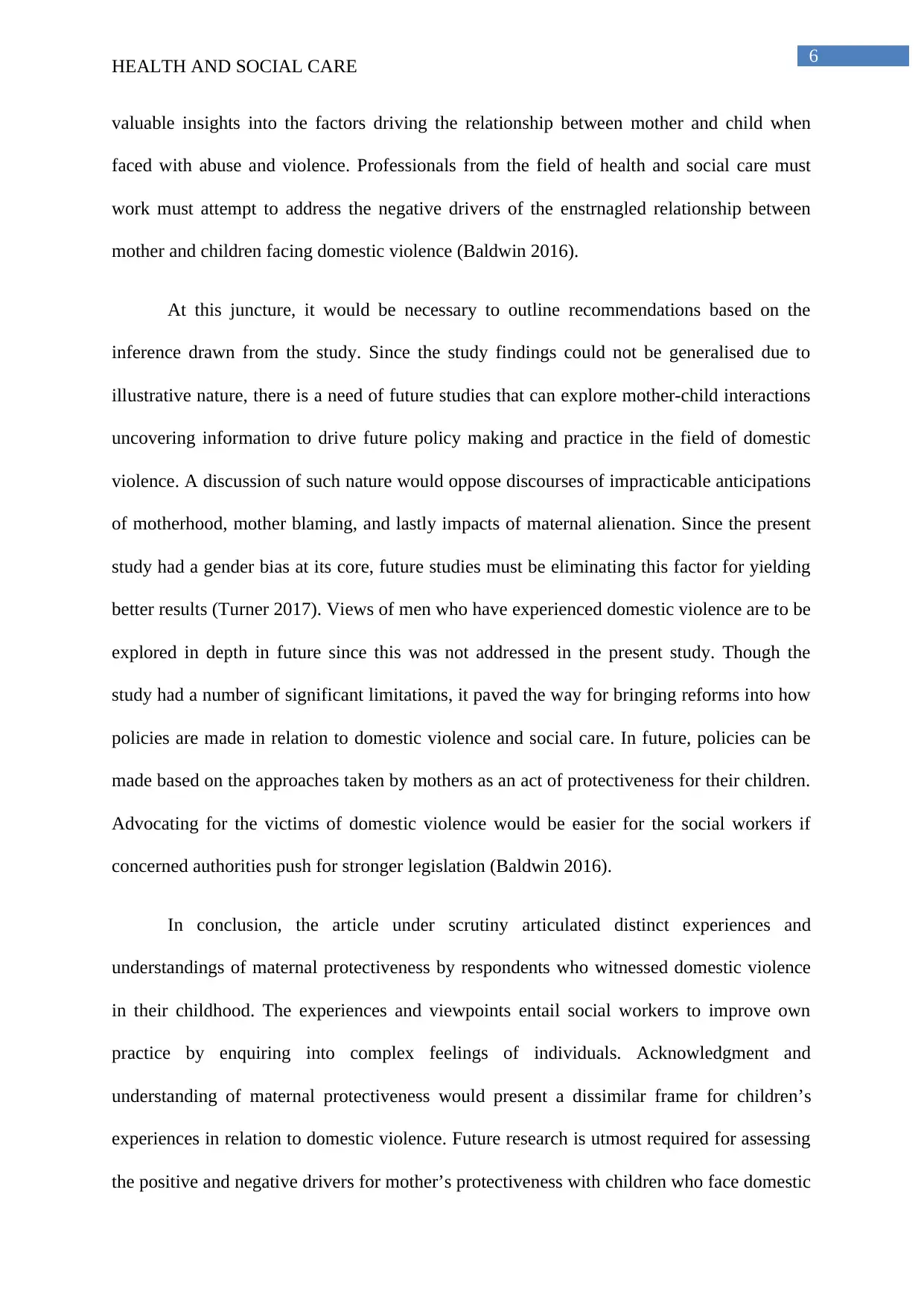
6
HEALTH AND SOCIAL CARE
valuable insights into the factors driving the relationship between mother and child when
faced with abuse and violence. Professionals from the field of health and social care must
work must attempt to address the negative drivers of the enstrnagled relationship between
mother and children facing domestic violence (Baldwin 2016).
At this juncture, it would be necessary to outline recommendations based on the
inference drawn from the study. Since the study findings could not be generalised due to
illustrative nature, there is a need of future studies that can explore mother-child interactions
uncovering information to drive future policy making and practice in the field of domestic
violence. A discussion of such nature would oppose discourses of impracticable anticipations
of motherhood, mother blaming, and lastly impacts of maternal alienation. Since the present
study had a gender bias at its core, future studies must be eliminating this factor for yielding
better results (Turner 2017). Views of men who have experienced domestic violence are to be
explored in depth in future since this was not addressed in the present study. Though the
study had a number of significant limitations, it paved the way for bringing reforms into how
policies are made in relation to domestic violence and social care. In future, policies can be
made based on the approaches taken by mothers as an act of protectiveness for their children.
Advocating for the victims of domestic violence would be easier for the social workers if
concerned authorities push for stronger legislation (Baldwin 2016).
In conclusion, the article under scrutiny articulated distinct experiences and
understandings of maternal protectiveness by respondents who witnessed domestic violence
in their childhood. The experiences and viewpoints entail social workers to improve own
practice by enquiring into complex feelings of individuals. Acknowledgment and
understanding of maternal protectiveness would present a dissimilar frame for children’s
experiences in relation to domestic violence. Future research is utmost required for assessing
the positive and negative drivers for mother’s protectiveness with children who face domestic
HEALTH AND SOCIAL CARE
valuable insights into the factors driving the relationship between mother and child when
faced with abuse and violence. Professionals from the field of health and social care must
work must attempt to address the negative drivers of the enstrnagled relationship between
mother and children facing domestic violence (Baldwin 2016).
At this juncture, it would be necessary to outline recommendations based on the
inference drawn from the study. Since the study findings could not be generalised due to
illustrative nature, there is a need of future studies that can explore mother-child interactions
uncovering information to drive future policy making and practice in the field of domestic
violence. A discussion of such nature would oppose discourses of impracticable anticipations
of motherhood, mother blaming, and lastly impacts of maternal alienation. Since the present
study had a gender bias at its core, future studies must be eliminating this factor for yielding
better results (Turner 2017). Views of men who have experienced domestic violence are to be
explored in depth in future since this was not addressed in the present study. Though the
study had a number of significant limitations, it paved the way for bringing reforms into how
policies are made in relation to domestic violence and social care. In future, policies can be
made based on the approaches taken by mothers as an act of protectiveness for their children.
Advocating for the victims of domestic violence would be easier for the social workers if
concerned authorities push for stronger legislation (Baldwin 2016).
In conclusion, the article under scrutiny articulated distinct experiences and
understandings of maternal protectiveness by respondents who witnessed domestic violence
in their childhood. The experiences and viewpoints entail social workers to improve own
practice by enquiring into complex feelings of individuals. Acknowledgment and
understanding of maternal protectiveness would present a dissimilar frame for children’s
experiences in relation to domestic violence. Future research is utmost required for assessing
the positive and negative drivers for mother’s protectiveness with children who face domestic

7
HEALTH AND SOCIAL CARE
violence in their upbringing. Translating research into practice would be helpful in all respect
within the society.
HEALTH AND SOCIAL CARE
violence in their upbringing. Translating research into practice would be helpful in all respect
within the society.
Paraphrase This Document
Need a fresh take? Get an instant paraphrase of this document with our AI Paraphraser
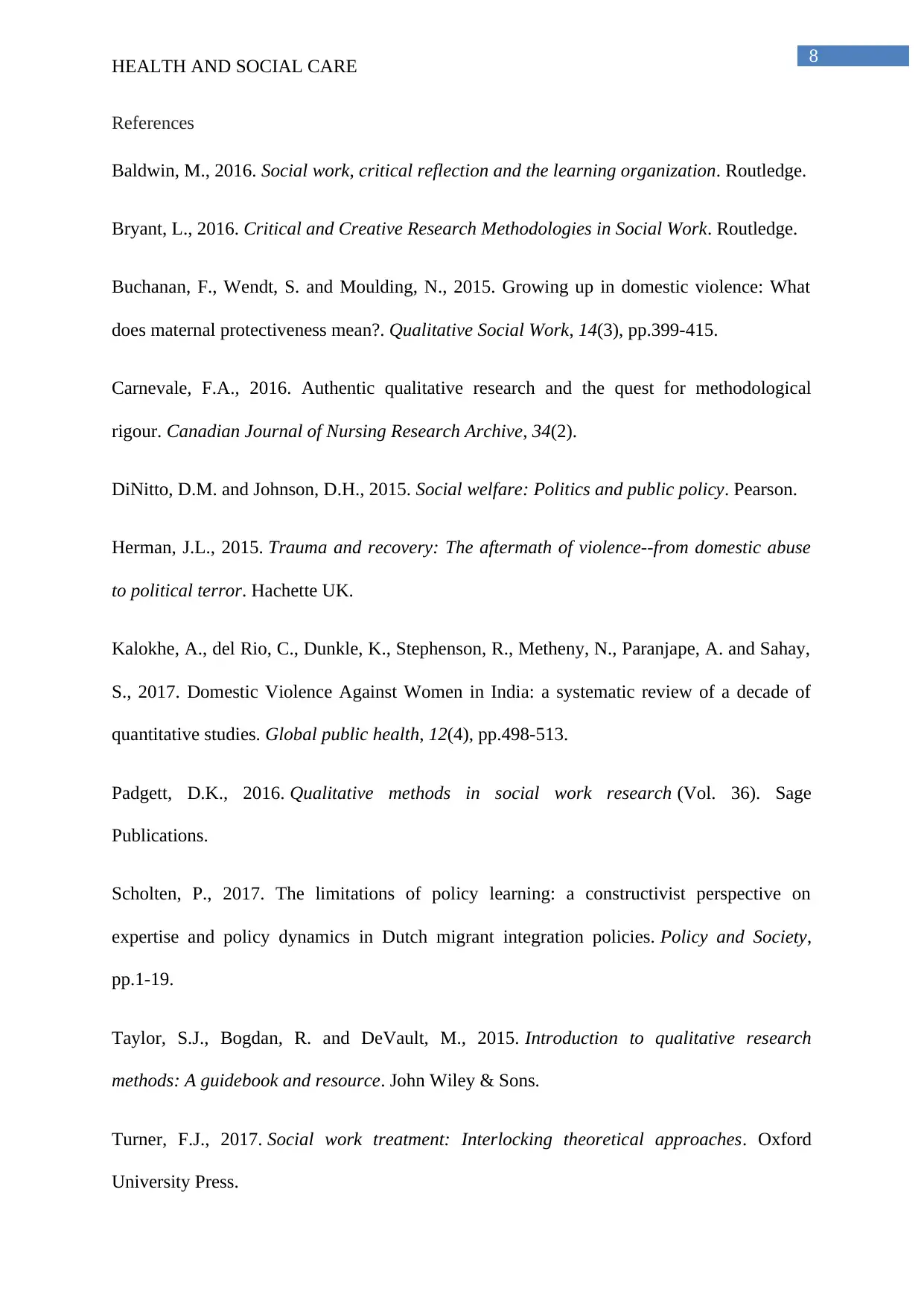
8
HEALTH AND SOCIAL CARE
References
Baldwin, M., 2016. Social work, critical reflection and the learning organization. Routledge.
Bryant, L., 2016. Critical and Creative Research Methodologies in Social Work. Routledge.
Buchanan, F., Wendt, S. and Moulding, N., 2015. Growing up in domestic violence: What
does maternal protectiveness mean?. Qualitative Social Work, 14(3), pp.399-415.
Carnevale, F.A., 2016. Authentic qualitative research and the quest for methodological
rigour. Canadian Journal of Nursing Research Archive, 34(2).
DiNitto, D.M. and Johnson, D.H., 2015. Social welfare: Politics and public policy. Pearson.
Herman, J.L., 2015. Trauma and recovery: The aftermath of violence--from domestic abuse
to political terror. Hachette UK.
Kalokhe, A., del Rio, C., Dunkle, K., Stephenson, R., Metheny, N., Paranjape, A. and Sahay,
S., 2017. Domestic Violence Against Women in India: a systematic review of a decade of
quantitative studies. Global public health, 12(4), pp.498-513.
Padgett, D.K., 2016. Qualitative methods in social work research (Vol. 36). Sage
Publications.
Scholten, P., 2017. The limitations of policy learning: a constructivist perspective on
expertise and policy dynamics in Dutch migrant integration policies. Policy and Society,
pp.1-19.
Taylor, S.J., Bogdan, R. and DeVault, M., 2015. Introduction to qualitative research
methods: A guidebook and resource. John Wiley & Sons.
Turner, F.J., 2017. Social work treatment: Interlocking theoretical approaches. Oxford
University Press.
HEALTH AND SOCIAL CARE
References
Baldwin, M., 2016. Social work, critical reflection and the learning organization. Routledge.
Bryant, L., 2016. Critical and Creative Research Methodologies in Social Work. Routledge.
Buchanan, F., Wendt, S. and Moulding, N., 2015. Growing up in domestic violence: What
does maternal protectiveness mean?. Qualitative Social Work, 14(3), pp.399-415.
Carnevale, F.A., 2016. Authentic qualitative research and the quest for methodological
rigour. Canadian Journal of Nursing Research Archive, 34(2).
DiNitto, D.M. and Johnson, D.H., 2015. Social welfare: Politics and public policy. Pearson.
Herman, J.L., 2015. Trauma and recovery: The aftermath of violence--from domestic abuse
to political terror. Hachette UK.
Kalokhe, A., del Rio, C., Dunkle, K., Stephenson, R., Metheny, N., Paranjape, A. and Sahay,
S., 2017. Domestic Violence Against Women in India: a systematic review of a decade of
quantitative studies. Global public health, 12(4), pp.498-513.
Padgett, D.K., 2016. Qualitative methods in social work research (Vol. 36). Sage
Publications.
Scholten, P., 2017. The limitations of policy learning: a constructivist perspective on
expertise and policy dynamics in Dutch migrant integration policies. Policy and Society,
pp.1-19.
Taylor, S.J., Bogdan, R. and DeVault, M., 2015. Introduction to qualitative research
methods: A guidebook and resource. John Wiley & Sons.
Turner, F.J., 2017. Social work treatment: Interlocking theoretical approaches. Oxford
University Press.
1 out of 8
Your All-in-One AI-Powered Toolkit for Academic Success.
+13062052269
info@desklib.com
Available 24*7 on WhatsApp / Email
![[object Object]](/_next/static/media/star-bottom.7253800d.svg)
Unlock your academic potential
© 2024 | Zucol Services PVT LTD | All rights reserved.